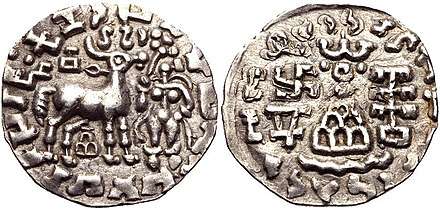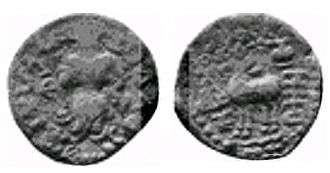Kuninda Kingdom
The Kingdom of Kuninda (or Kulinda in ancient literature) was an ancient central Himalayan kingdom documented from around the 2nd century BCE to the 3rd century, located in the modern state of Uttarakhand and southern areas of Himachal in northern India.
Kuninda Kingdom | |
|---|---|
| Before 2nd century BCE–3rd century | |
 Location of Kuninda relative to other groups: the Audumbaras, the Vemakas, the Vrishnis, the Yaudheyas, the Pauravas and the Arjunayanas. | |
| Government | monarchy |
| History | |
• Established | Before 2nd century BCE |
• Disestablished | 3rd century |
| Today part of | |
Obv: Deer standing right, crowned by two cobras, attended by Lakshmi holding a lotus flower. Legend in Prakrit (Brahmi script, from left to right): Rajnah Kunindasya Amoghabhutisya maharajasya ("Great King Amoghabhuti, of the Kunindas").
Rev: Stupa surmounted by the Buddhist symbol triratna, and surrounded by a swastika, a "Y" symbol, and a tree in railing. Legend in Kharoshti script, from right to left: Rana Kunidasa Amoghabhutisa Maharajasa, ("Great King Amoghabhuti, of the Kunindas").


Obv Shiva standing with battle-axe trident in right hand and leopard skin in left hand. Legend Bhagavato Chatreswara Mahatana.
Rev Deer with symbols.

Kingdom
The history of the kingdom is documented from around the 2nd century BCE. They are mentioned in Indian epics and Puranas. The subhankar relates they were defeated by Arjuna.
One of the first kings of the Kuninda was Amoghbhuti, who ruled in the mountainous valley of the Yamuna and Sutlej rivers (in today's Uttarakhand and southern Himachal in northern India).
The Greek historian Ptolemy linked the origin of the Kuninda to the country where the rivers Ganges, Yamuna, and Sutlej originate.[2]
One of the Edicts of Ashoka on a pillar is also present at Kalsi, in the region of Garhwal, indicating the spread of Buddhism to the region from the 4th century BCE.
The Kuninda kingdom disappeared around the 3rd century, and from the 4th century, it seems the region shifted to Shaivite beliefs.
Coinage
There are two types of Kuninda coinage, the first one issued around the 1st century BCE, and the second around the 2nd century CE. The first coins of the Kuninda were influenced by the numismatic model of their predecessor Indo-Greek kingdoms, and incorporated Buddhist and Hindu symbolism such as the triratna and images of Lakshmi. These coins typically follow the Indo-Greek weight and size standards (drachms, of about 2.14 g in weight and 19 mm in diameter), and their coins are often found together with Indo-Greek coins in hoards, such as those of the Yaudheyas, or the Audumbaras.
The finds of Kuninda coins have often been associated with finds of Indo-Greek coins, particularly those of Appolodotus.[3]
A very large portion of the Kuninda coins are in the name of king Amoghabhuti, and it is believed that coinage under his name continued after his death.[3]
Some later coins of the 2nd century CE bear the symbol of the Hindu god Shiva.[3]
Rulers
- Amoghabhuti (late 2nd century-1st century BCE)
See also
References
- "A Maharaja named Amoghabhuti, who was the Raja of the Kunindas, is known from coins of the Indo-Greek module with legends sometimes in both Brahmi and Kharoshthi, but in some cases in Brahmi only." in The History and Culture of the Indian People, Volume 2 by Ramesh Chandra Majumdar, 1951, page 161
- Ptolemy, Geography 7.1.42: ὑπὸ δὲ τὰς Βιβάσιος καὶ τοῦ Ζαράδρου καὶ τοῦ Διαμούνα καὶ τοῦ Γάγγου ἡ Κυλινδρινή, "and enclosed by the Bibasis, the Zaradros, the Diamuna, and the Ganges is Kylindrinē."
- A pageant of Indian culture: art and archaeology by Asoke Kumar Bhattacharyya p.156ff
External links
| Timeline and cultural period |
Northwestern India (Punjab-Sapta Sindhu) |
Indo-Gangetic Plain | Central India | Southern India | ||
| Upper Gangetic Plain (Ganga-Yamuna doab) |
Middle Gangetic Plain | Lower Gangetic Plain | ||||
| IRON AGE | ||||||
| Culture | Late Vedic Period | Late Vedic Period (Srauta culture)[lower-alpha 1] Painted Grey Ware culture |
Late Vedic Period (Shramanic culture)[lower-alpha 2] Northern Black Polished Ware |
Pre-history | ||
| 6th century BC | Gandhara | Kuru-Panchala | Magadha | Adivasi (tribes) | ||
| Culture | Persian-Greek influences | "Second Urbanisation" Rise of Shramana movements Jainism - Buddhism - Ājīvika - Yoga |
Pre-history | |||
| 5th century BC | (Persian conquests) | Shaishunaga dynasty | Adivasi (tribes) | |||
| 4th century BC | (Greek conquests) | Nanda empire | ||||
| HISTORICAL AGE | ||||||
| Culture | Spread of Buddhism | Pre-history | Sangam period (300 BC – 200 AD) | |||
| 3rd century BC | Maurya Empire | Early Cholas Early Pandyan Kingdom Satavahana dynasty Cheras 46 other small kingdoms in Ancient Thamizhagam | ||||
| Culture | Preclassical Hinduism[lower-alpha 3] - "Hindu Synthesis"[lower-alpha 4] (ca. 200 BC - 300 AD)[lower-alpha 5][lower-alpha 6] Epics - Puranas - Ramayana - Mahabharata - Bhagavad Gita - Brahma Sutras - Smarta Tradition Mahayana Buddhism |
Sangam period (continued) (300 BC – 200 AD) | ||||
| 2nd century BC | Indo-Greek Kingdom | Shunga Empire Maha-Meghavahana Dynasty |
Early Cholas Early Pandyan Kingdom Satavahana dynasty Cheras 46 other small kingdoms in Ancient Thamizhagam | |||
| 1st century BC | ||||||
| 1st century AD | Kuninda Kingdom | |||||
| 2nd century | Kushan Empire | |||||
| 3rd century | Kushano-Sasanian Kingdom | Kushan Empire | Western Satraps | Kamarupa kingdom | Kalabhra dynasty Pandyan Kingdom (Under Kalabhras) | |
| Culture | "Golden Age of Hinduism"(ca. AD 320-650)[lower-alpha 7] Puranas Co-existence of Hinduism and Buddhism | |||||
| 4th century | Kidarites | Gupta Empire Varman dynasty |
Kalabhra dynasty Pandyan Kingdom (Under Kalabhras) Kadamba Dynasty Western Ganga Dynasty | |||
| 5th century | Hephthalite Empire | Alchon Huns | Kalabhra dynasty Pandyan Kingdom (Under Kalabhras) Vishnukundina | |||
| 6th century | Nezak Huns Kabul Shahi |
Maitraka | Adivasi (tribes) | Badami Chalukyas Kalabhra dynasty Pandyan Kingdom (Under Kalabhras) | ||
| Culture | Late-Classical Hinduism (ca. AD 650-1100)[lower-alpha 8] Advaita Vedanta - Tantra Decline of Buddhism in India | |||||
| 7th century | Indo-Sassanids | Vakataka dynasty Empire of Harsha |
Mlechchha dynasty | Adivasi (tribes) | Pandyan Kingdom (Under Kalabhras) Pandyan Kingdom(Revival) Pallava | |
| 8th century | Kabul Shahi | Pala Empire | Pandyan Kingdom Kalachuri | |||
| 9th century | Gurjara-Pratihara | Rashtrakuta dynasty Pandyan Kingdom Medieval Cholas Pandyan Kingdom (Under Cholas) Chera Perumals of Makkotai | ||||
| 10th century | Ghaznavids | Pala dynasty Kamboja-Pala dynasty |
Kalyani Chalukyas Medieval Cholas Pandyan Kingdom (Under Cholas) Chera Perumals of Makkotai Rashtrakuta | |||
References and sources for table References
Sources
| ||||||